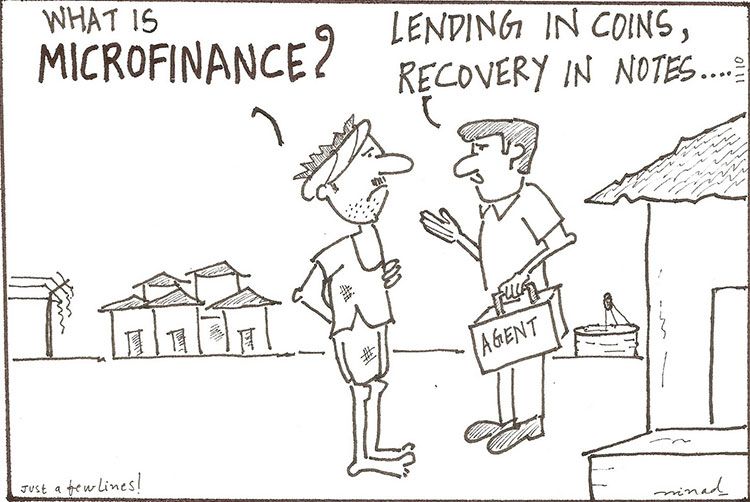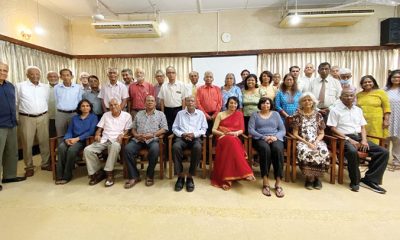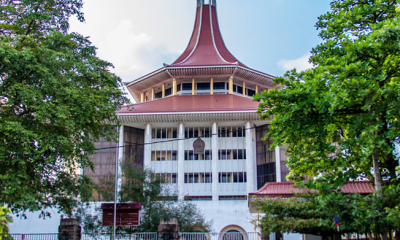Features
Is Microfinance making poverty worse?

 The Food and Agriculture Organization of the United Nations (FAO) says that the alleviation of extreme poverty by 2030 requires major policy reforms. For this purpose, the FAO and many scholars agree that these policy changes should be focused on perspectives such as human rights, equal and inclusive opportunities and diversity. Addressing the issues pertaining to many of these perspectives largely depend on the income levels of people. Individual incomes are mainly derived from value creation by productive activities which in turn produce income for people by way of profits and/or wages.
The Food and Agriculture Organization of the United Nations (FAO) says that the alleviation of extreme poverty by 2030 requires major policy reforms. For this purpose, the FAO and many scholars agree that these policy changes should be focused on perspectives such as human rights, equal and inclusive opportunities and diversity. Addressing the issues pertaining to many of these perspectives largely depend on the income levels of people. Individual incomes are mainly derived from value creation by productive activities which in turn produce income for people by way of profits and/or wages.
As the vast majority of poor people live in areas with poor infrastructure facilities such as mobility, electricity and water, a more popular methodology for developing local rural economies has been promoting Microfinance (MF) strategy in many countries until the recent past. MF strategy had been augmented with popular sweeten such as ‘stronger rural-urban economic linkages’, ‘accelerated adoption of climate- smart’ and ‘sustainable production methods’ etc. Even Professor Yunus was awarded Nobel Peace Award for the ‘successful implementation’ of the MF system in Bangladesh and with the patronage of the UN, the MF program was replicated in many developing countries.
Today, after 30-40 years of experimentation with the MF system, the evidence shows inconsistent and contradictory results and poverty remains a major concern in many countries including those which implemented the MF strategy widely. (Visit www.bloomberg.com/graphics/2022-microfinance-banks-profit-off-developing-world)
Cambodia stands out as an emblematic case illustrating the potential pitfalls of microfinance. Over the decade leading up to 2021, the loan portfolio of microfinance companies in the country surged by approximately 13 times, reaching a staggering $8.7 billion. This exponential growth was fueled by the diversification of credit products, including offerings such as household finance and loans to small and medium-sized businesses.
A leading microfinance company, originating in the 1990s with a mission to provide affordable loans to impoverished rural women, was initially established under a different name by Catholic Relief Services, a US-based charity affiliated with the Catholic Church. In the 2000s, as Cambodia experienced rapid economic growth, particularly notable in Southeast Asia, the microfinance sector became increasingly lucrative, attracting substantial foreign capital.
In 2009, the aforesaid company, one of the nation’s major microlenders, reported that micro loans constituted 99% of its gross loan portfolio, with household finance comprising a mere 1%. However, by 2018, a Bloomberg analysis of Microfinance Information Exchange (MIX) data revealed a significant shift. Micro loans’ share had decreased to 65%, while household finance had grown to 22%.
A 2020 report from the Microfinance Index of Market Outreach and Saturation (Mimosa) disclosed that one in five adults in Cambodia held a microloan, contributing to the country’s alarming credit-saturation score. The situation worsened when the National Bank of Cambodia implemented an 18% rate cap in 2017. In response, lenders not only increased loan sizes but also tripled commission fees, intensifying the challenges faced by borrowers. This scenario, as outlined in an International Monetary Fund report, underscores the complex dynamics and unintended consequences that can arise within the microfinance landscape.
While numerous borrowers faced income losses during the pandemic, the above-mentioned company reported a remarkable net profit of $45.4 million in 2020, marking a 33% increase from the previous year. Notably, its return on equity for that year stood at 28%, surpassing more than three times the average for commercial lenders in Cambodia. Despite documented reports of abusive practices, the company has received over $25 million in funding from French and Norwegian development banks since 2020, as indicated by a review of their portfolios.
US officials expressed deep concerns about the potential repercussions for borrowers in Cambodia, particularly the risk of losing their homes. Many officials argued against subsidizing microlenders that accepted land titles as collateral. Wade Channell, a former senior economic adviser at USAID, strongly emphasized the ethical considerations, stating, “It’s unethical to create secured lending to the poor based on mortgages or land titles because the poor, by definition, can’t repay. What you end up creating is a homelessness project.”
“I wanted everything to be over,” confesses Madhuka Kumari, a 30-year-old mother of five, seated on the veranda of her sister-in-law’s house near an elephant preserve in central Sri Lanka. “Everyone was shouting at me. Dying felt like the only option.”, reported by Bloomberg in their exclusive investigative analytical report “microfinance-banks-profit-off-developing-world” in May 2022.
Kumari had borrowed $425 from a Sri Lankan lending unit of the above-mentioned Cambodian microfinance company to initiate a small business selling mats. When heavy rains disrupted transportation, impeding her ability to make the monthly $30 payments, loan officers reportedly arrived at her house near the town of Minneriya. According to Kumari, they shouted at her in front of her family and neighbors, insisting she sell her possessions, and even threatening to involve the police. This led to conflicts with her husband, who was unaware of the loan. In 2018, after enduring months of despair, she resorted to pouring kerosene over herself and setting herself on fire while her children slept, all while being five months pregnant at the time.
Kumari’s husband intervened, extinguishing the flames and rushing her to the hospital. During her hospitalization, Kumari alleges that loan officers visited her bedside, demanding payments.
The company denied any claims that its agents pressured Kumari or visited her during her hospitalization. A company spokesperson stated in an email, “This incident was due to a domestic dispute and not due to over-indebtedness,” and noted they had received no complaints. However, Kumari contends that it was the aggressive tactics employed by the loan officers that drove her to attempt suicide.
The FAO highlights the global decline in poverty, yet its uneven progress remains a concern, particularly in rural areas where extreme poverty is concentrated. The FAO emphasizes that low-income countries, especially in sub-Saharan Africa, face slower advancements and an increasing absolute number of poor individuals. With an estimated 1.2 billion people still living in extreme poverty, eradicating poverty remains a formidable challenge, central to the post-2015 development agenda.
The multifaceted nature of poverty is characterized by low income, limited assets, and inadequate employment opportunities, often compounded by gender disparities. The impoverished, predominantly residing in rural areas, lack access to quality infrastructure and face challenges in accumulating capital for income-generating activities.
Microfinance, heralded as a solution, has emerged as a widespread poverty alleviation strategy in developing countries. However, after nearly four decades of implementation, concerns arise regarding its efficacy. The Grameen Bank model, pioneered by Nobel laureate Professor Muhammad Yunus, is under scrutiny to determine whether microfinance has genuinely empowered the impoverished or inadvertently sustained the cycle of poverty.
Critics argue that microfinance programmes, while creating organizational networks, may not significantly impact poverty exit, especially in regions facing severe market and infrastructure constraints. Challenges such as inflexible group enforcement, high-interest rates, and limited impact on household welfare for the poorest participants raise questions about the sustainability and genuine effectiveness of microfinance.
Many studies explore the role of legal property systems in fostering economic growth, challenging the notion that developing countries lack the assets needed for poverty elimination. It questions whether microfinance institutions, striving for a double bottom line, truly benefit the poor or inadvertently trap them in debt.
As Sub-Saharan Africa experiences a continuous rise in extreme poverty, scholars and researchers debate whether microfinance, once seen as a beacon of hope, may, in reality, serve as a trap that pacifies rural disadvantaged groups without lifting them out of poverty.
(The writer, a senior Chartered Accountant and professional banker, is Professor at SLIIT University, Malabe. He is also the author of the “Doing Social Research and Publishing Results”, a Springer publication (Singapore), and “Samaja Gaveshakaya (in Sinhala). The views and opinions expressed in this article are solely those of the author and do not necessarily reflect the official policy or position of the institution he works for. He can be contacted at saliya.a@slit.lk and www.researcher.com)
Features
Prof. Lal Tennekoon: An illustrious but utterly unpretentious and much -loved academic

Professor Basil Laliputhra Tennekoon, Emeritus Professor of Civil Engineering at the University of Moratuwa, was called to rest on 30 March 2025 at the age of 82. He was educated at S. Thomas’ College, Mt. Lavinia, where he won the Miller Mathematics Prize in 1960, an achievement that gets one’s name on a board in the college hall. The prize is named after Rev. Edward Miller, the fifth warden of the school, who had read mathematics at Cambridge. Young Tennekoon fulfilled this early promise, obtaining first class honours in civil engineering from the University of Peradeniya in 1965. There were many Thomians who entered the engineering faculty with him, including Shanthi Kumar Rasaratnam (now holding an MBE for services to water engineering in the UK), Mano Ponniah (who later played first class cricket for Cambridge and All-Ceylon), and Gerard Rodrigo (subsequently a Marxist development economist).
Lal Tennekoon went on to complete his PhD at Cambridge University in 1970, on the behaviour of foundations on sandy soils. Other notable Peradeniya graduates/academics who completed PhDs in Cambridge around this time included Alagiah Thurairajah (1962, on shear properties of soils), Munidasa Ranaweera (1969, on the finite element method applied to limit analysis) and Vickramabahu Karunaratne (1970, on plasma physics) – halcyon days for Peradeniya engineering, no doubt. For six years after his PhD, Tennekoon was attached to the Faculty of Engineering at Peradeniya, teaching at both undergraduate and postgraduate levels. He joined the Katubedda Campus of the University of Sri Lanka in 1975 and became a Professor of Civil Engineering at the University of Moratuwa in 1984 and Senior Professor in 1994. Moratuwa was fortunate to obtain his services. When I once suggested that his moving to Moratuwa was a result of “the best people gravitating to the best places”, his rejoinder was that he would have found it difficult, after he got married to Preethi, to keep pace with Thurairajah’s work ethic in the Peradeniya soil mechanics lab!
He guided the fortunes of the Civil Engineering Department as its Head from 1980 to 1985, during which time the annual undergraduate intake was increased from 50 to 100, and a new civil engineering complex was constructed to accommodate that increase. He also steered the Faculty of Engineering as its Dean for 10 months in 1994/1995, when there was sharp division in the university regarding the continuation of the NDT programme within the Faculty.
Professor Tennekoon’s main research interests were based around the problems facing the geotechnical engineers of this country. These were in the areas of: (i) Shallow foundations in low lying areas containing peat and organic clays; (ii) Pile foundations terminating on rock; (iii) Landslides and the stabilisation of slopes; and (iv) Site Investigations for all types of civil engineering structures. He also chaired the Moratuwa University’s Senate Research Committee from around 1998 to 2002 and was responsible for setting up the Research Awards Scheme, which contributed significantly to raising research quality at the university.
Over his illustrious career, he provided assistance to many development projects in the country during their planning, design and construction stages, in the collection and interpretation of geotechnical data. Notable contributions have been in (i) the Environmental Improvement Project for the city of Colombo; (ii) the Southern Highway Project from Colombo to Matara; (iii) the Beira Lake Restoration Project; and (iv) several multi-storeyed building projects such as Ceylinco Celestial Towers, Crescat Towers, HNB Tower, Bank of Ceylon Tower, Central Bank Tower and Havelock City Project. He worked closely with Geotech (Pvt) Ltd, where his close friend Eng. Parakrama Jayasinghe was Managing Director. At times he enlisted the services of his colleagues, most of them his juniors. The consideration paid by this senior engineer to the disciplinary competencies of his younger associates only served to increase our own reciprocal respect for him.
Professor Tennekoon served as the principal author for the development of two standards for the Institute of Construction Training and Development (ICTAD), in which his research findings were also incorporated. The two standards were in the areas of ‘Site Investigation’, and ‘Pile foundations end bearing on rock’; and were published by the Sri Lanka Standards Institution (SLSI). He was a Founder Member of the Sri Lanka Geotechnical Society (SLGS) in 1987; and held its Presidency from 1994 to 2000. He was recognised for his contributions to the Geotechnical Engineering profession in Sri Lanka by the SLGS at an International Conference organised by the Society in 2007. The Institution of Engineers Sri Lanka bestowed on him an Award for Excellence in 2008. He was elected a Fellow of the National Academy of Sciences of Sri Lanka in 2013.
In April 2003, Professor Tennekoon was invited by the Government of Sri Lanka to be part of a team for implementing the World Bank funded project for the Improvement of Relevance and Quality of Undergraduate Education (IRQUE). This was a 6-year project where the major component was the establishment of a Quality Enhancement Fund (QEF). This was to be a strategy in which quality and relevance were to be improved through the entire university system by the implementation of a competitive funding scheme. Professor Tennekoon was responsible for the implementation of this QEF component, which often involved choosing between competing study programmes. His dispassionate judgment and clinical impartiality ensured the smooth operation of this project; it also endeared him to virtually the entire university community in Sri Lanka. Some of us wondered whether he was deserting his primary calling to engineering through this involvement, but he was only broadening his horizons. He later became passionate about outcome based engineering education, and chaired the Accreditation Board of the Institution of Engineers, Sri Lanka, responsible for accrediting engineering programmes under the Washington Accord.
Twenty eight years ago, Lal Tennekoon suffered a massive heart attack and was in the intensive care unit for many days. His loving wife Preethi and his children Layanthi and Banuka rarely left the hospital premises, at times camping out on its staircases, as I recall. Theirs was clearly a very loving family. How fortunate that we all got him back from the brink of death. From a private communication he circulated to some of us soon after, I am aware that he was extremely grateful to all who attended on, ministered to and prayed for him. He himself looked after his wife caringly, eschewing all professional and other engagements, towards the end of her life. Preethi’s demise hastened his own.
Professor Lal Tennekoon was an illustrious but utterly unpretentious and much loved academic; a greatly sought after and highly respected geotechnical consultant; and a passionate advocate for outcome based engineering education. His twin concerns for practice oriented research on the one hand and engineering education on the other, continue to be nurtured by those he engaged with. His geotechnical expertise endures in the careers of his one-time students, all now emeritus or full professors themselves – Professor Anuruddha Puswewala (rock mechanics); Professor Athula Kulathilake (slope stability); Professor Saman Thilakasiri (piled foundations); Professor Udeni Nawagamuwa (environmental geotechnics); and Professor Nalin de Silva (shallow foundations).
Professor Priyan Dias (a student and later colleague of Professor Lal Tennekoon)
Features
Sri Lanka’s foreign policy amid geopolitical transformations: 1990-2024 – Part VII

(Continued from yesterday)
China and Sri Lanka discovered that their interests were closely aligned in the evolving post-war strategic landscape. China served as a vital diplomatic shield for Sri Lanka, particularly in countering UN resolutions amid international scrutiny over its actions. For China, Sri Lanka was a crucial link in the Belt and Road Initiative, serving as a strategic hub for infrastructure investment in the Indian Ocean region.
Since 2009, Sino-Sri Lanka relations have expanded rapidly across multiple sectors. China has emerged as Sri Lanka’s leading source of foreign direct investment (FDI), funding large-scale infrastructure projects such as the Hambantota Port, Mattala Airport, the Southern Expressway, the Norochcholai coal power plant, and a $500 million expansion of Colombo’s South Harbour. In May 2013, the two countries signed a Strategic Cooperative Partnership (SCP), encompassing trade, investment, financial assistance, and strategic cooperation. The geopolitical implications of these developments are evident in projects like the Trincomalee-based Sri Lankan Air Force maintenance workshop awarded to a Chinese firm.
These initiatives triggered reactions from regional powers, particularly India and Japan, which view them as components of China’s expanding “Maritime Silk Road” and “String of Pearls” strategy in the Indian Ocean. India and the United States have formally conveyed concerns to Sri Lankan authorities about the strategic implications of China’s involvement in the Hambantota Harbour and Colombo Port City projects. Sri Lanka’s foreign policy has shown little strategic foresight and diplomatic acumen in managing this delicate situation.
Foreign policy Dilemmas of Yahapalanaya: Breakthroughs and Vacillations
The domestic context of foreign policy shifted once again when the National Unity Government (NUG), commonly known as Yahapalana government, came to power following the Presidential election on January 8, 2015. The blatant democracy backsliding since 2009, coupled with misuse of power, widespread corruption and state extravagance, gust a political wind—originating within civil society—that ultimately unseated the seemingly invincible Mahinda Rajapaksa regime. A new discourse on democracy and good governance emerged, shaping the narrative in guiding political development. Soon after coming to power, the Yahapalana government introduced the 19th Amendment to the Constitution on April 28, 2015, as an initial step toward broad democratic reforms. The amendment imposed checks on the President’s executive powers and included certain provisions to promote good governance. The country’s political atmosphere changed markedly after the unseating of the Mahinda Rajapaksa regime.
As far as foreign policy is concerned, the Yahapalana government signaled its willingness to engage more constructively with the international community, particularly the United Nations, departing from the confrontational approach of its predecessor. This shift was evident in several key developments. In March 2015, the U.S. Commission on International Religious Freedom (USCIRF) visited Sri Lanka, followed by the UN Working Group on Enforced or Involuntary Disappearances (WGEID) in November—the latter marking its first visit in 16 years. The government’s changed approach was most notably demonstrated at the 30th Session of the UN Human Rights Council, where Sri Lanka collaborated with other Council members to co-sponsor the resolution Promoting Reconciliation, Accountability, and Human Rights in Sri Lanka, which was adopted by consensus.
The initial steps taken by the Yahapalana
government in democracy building and good governance helped restore democratic credibility of Sri Lanka before the international community. The focus on good governance, accountability, and anti-corruption resonated with Western countries that champion these principles in the international arena. In addition to the 19th Amendment to the Constitution, there were other initiatives in that direction. The right to information was incorporated into the Fundamental Rights Chapter of the Constitution, making it a judicially enforceable right. A key milestone in this regard was the enactment of the Right to Information Act, which, after a prolonged gestation period, was finally implemented in February 2017. Meanwhile, the process of drafting a new constitution began with the transformation of Parliament into a Constituent Assembly. A Steering Committee was established, which submitted its interim report on September 26, 2017.
The international pressure that was mounting on Sri Lanka before 2015 was eased significantly due to the Yahapalana government’s approach to national reconciliation. This approach was built on four key main pillars: truth-seeking, the right to justice, reparation, and non-recurrence. As an initial step, the government appointed the Consultation Task Force on Reconciliation Mechanisms (CTFRM) on January 26, 2016.
Amid changing domestic dynamics, Sri Lanka’s foreign policy priorities were redefined, particularly in relation to its three geopolitical spheres. The Indian Ocean once again became a priority in foreign policy, reflected in the establishment of the Indian Ocean Secretariat under the Prime Minister’s purview. Recognising shifts in the regional and global balance of power—across South Asia, the Indian Ocean, and beyond—the Yahapalana government sought to restore balance in its foreign policy. India, an emerging blue-water naval power, is Sri Lanka’s closest neighbour. China, a rising superpower with an expanding naval presence in the Indian Ocean, remains Sri Lanka’s principal source of foreign direct investment. Meanwhile, the United States, the dominant naval power in the region, continues to play a crucial role. Sri Lanka’s economic ties also shaped its foreign policy calculus. While India is its second-largest trading partner, China remains a major investor. At the same time, Western markets continue to be vital for Sri Lanka’s exports, with 27% of total exports going to the United States, 27% to the EU, and 10% to Britain. India is Sri Lanka’s second largest trading partner.
Sri Lanka has preferred to be in the Indian Ocean framework rather than the broader Indo-Pacific construct. Recognising the strategic volatility of the region, the Yahapalanaya government maintained that the dominance of the Indian Ocean by any single power would be detrimental to Sri Lanka’s national interests. At this critical juncture, a small island state like Sri Lanka cannot afford to be a passive observer. Sri Lanka has consistently championed a peaceful and stable maritime environment. Ensuring freedom of navigation and securing sea lanes of communication remain central to this vision.
The Yahapalana Government prioritized economic diplomacy. Recognising the global shift in economic and financial power toward ‘emerging Asia’, the government understood that the Indian Ocean was becoming a focal point of global economic influence. In this context, a key policy challenge was determining how best to leverage Sri Lanka’s strategic location and human capital to integrate into Asia’s economic growth.
Sri Lanka’s deepening economic crisis, particularly its mounting debt repayment challenges, had profound implications for its foreign policy under the Yahapalana government. In an effort to mitigate its balance of payment problem, the government signed a controversial agreement in August 2017 with China Merchants Port Holdings (CM Port), leasing a 70% stake in the Hambantota Port for 99 years in exchange for $1.12 billion. This deal not only underscored Sri Lanka’s growing dependence on Chinese investment to manage its financial distress but also highlighted the complex interplay between economic crisis and strategic foreign policy decisions. While the agreement carried significant political and geopolitical ramifications, Sri Lanka’s options at the time appeared severely limited.
Although the Yahapalana government prioritised economic diplomacy, its track record in this area was not impressive. Efforts to revive the economy through foreign investment yielded underwhelming results. The government worked hard to secure Sri Lanka’s qualification for the U.S. Millennium Challenge Corporation (MCC) compact grant. Ultimately, in April 2019—toward the end of its tenure—MCC offered Sri Lanka a $480 million outright grant to upgrade urban transport, modernise the land registration system, and build rural roads connecting highways. Similarly, the Yahapalana government entered into an agreement with the Japan International Cooperation Agency (JICA) for a Light Rail Transit (LRT) project under highly concessional terms. However, the project failed to take off before the 2019 presidential election.
The Yahapalana government’s indecision and delays were evident in the development of the East Container Terminal (ECT). After prolonged uncertainty, the Sri Lanka Ports Authority (SLPA) finally signed a tripartite agreement with the governments of Japan and India in May 2019 to develop the terminal. However, before finalising the restructuring of the India-Japan joint venture and the capital infusion plan, the Yahapalana government collapsed. The government’s hesitation in making critical policy decisions, even after initiating processes with major international partners, has eroded Sri Lanka’s credibility on the global stage.
Given the significance of the Tamil Diaspora in the international public sphere, engaging with them remained a key challenge in Sri Lanka’s post-war foreign policy. Successive Sri Lankan governments, both during and after the war, struggled to establish a constructive dialogue with the Tamil Diaspora, largely due to their failure to recognise its diversity. As Foreign Minister of the Yahapalana Government (2015–2017), Mangala Samaraweera made a concerted effort to engage with the Diaspora, particularly the Global Tamil Forum (GTF), aiming to integrate them into Sri Lanka’s national reconciliation process. However, his initiative remained largely personal and lacked broader government support. Following his departure from the Foreign Ministry in mid-2017, the effort lost momentum.
The Yahapalana government struggled to sustain its initial momentum in promoting democracy and good governance, ultimately failing to maintain a consistent policy direction. Indecision and frequent policy reversals came to define its domestic governance. A key example was its approach to transitional justice. While the government initially demonstrated enthusiasm for establishing the Office on Missing Persons (OMP), this commitment soon waned. By the time the Consultation Task Force on Reconciliation Mechanisms (CTFRM) submitted its final report in November 2016, the initial drive had significantly diminished. Notably, neither the President nor the Prime Minister attended the report’s handover, signaling a lack of political will. After prolonged delays, the OMP was finally established in March 2018—almost two years after its initial proposal, highlighting the government’s slow and inconsistent approach to key reforms.
Divisions within the government emerged before its second year in office, preventing a unified stance on key policies, including foreign affairs. On critical issues, the President, Prime Minister, and Foreign Minister often voiced conflicting positions, creating confusion. This persistent inconsistency left the international community uncertain and bewildered.
The rift between the President and the Prime Minister of the Yahapalana Government reached a crisis point on October 26, 2018, when the President dismissed the Prime Minister and appointed Mahinda Rajapaksa in his place. The Supreme Court later ruled the President’s actions unconstitutional and reversed his decisions. However, this exposed the underlying tensions within the Yahapalana Government, turning a hidden cold war into an open conflict that paralysed the country’s public administration. Meanwhile, the Central Bank bond scam inflicted irreparable damage on the government’s anti-corruption credibility. The faltering pace of democratic reforms, economic stagnation, and infighting within the political leadership created a bleak political atmosphere. In this context, the carefully coordinated suicide bombings on April 21, 2019, carried out by a little-known Islamic terrorist group, shifted the national discourse from democracy and good governance to security and strong leadership.
by Gamini Keerawella
(To be continued)
Features
Better New Year, T vs. H, and other quirky announcements

 Cassandra flopped down on her favourite sofa satiated with kavun, kokis and athiraha. She missed her treacle filled coils of ulundu – unduvel – which are elegant, smallish and slightly crunchy total delights; a specialty of the Kandy region. They are basically pani walalu, but unique in their smaller coils and taste; different from jalabi and those which you can buy at the Avan Hala below the Ambepussa Rest house, named hotel or resort or whatever now.
Cassandra flopped down on her favourite sofa satiated with kavun, kokis and athiraha. She missed her treacle filled coils of ulundu – unduvel – which are elegant, smallish and slightly crunchy total delights; a specialty of the Kandy region. They are basically pani walalu, but unique in their smaller coils and taste; different from jalabi and those which you can buy at the Avan Hala below the Ambepussa Rest house, named hotel or resort or whatever now.
Cassandra remembers in the dim distant past how she used to sit beside her youngest aunt, a wizard of a cook and sweet maker, to turn out the unduvel, be it for Aluth Avurudhu, a dane or a celebration of some family event. Punchi Punchi Amma would sit on a colomba (as we named the low small benches) by the sizzling oil pan on a hearth on the ground, and squeeze out the mixture from a muslin bag with a hole of the correct dimension at its extremity. She skillfully twirled her hands guiding the emerging undu mixture to coil in the oil. My great task, seated beside her, was to soak the cooked coils which she dropped into the muttiya of kitul treacle. An angry hiss ensued but the contrast of heat between coil and treacle made the latter creep into the spaces of the coils. Thus, the delight when biting into an unduvel
Excuse the diversion of a cooking lesson in this column usually loaded with acidity if not venom. The benign ennui of Avurudu is still with Cass, purring like a cat who got the cream.
Now for the comments. The mood of sanguinity is still with Cass. That word is loaded with meaning including hopefulness, optimism, joy and other glad feelings. Justified feeling since all of those who spoke into TV mikes from markets, shops, bus halts, railway stations, said it was a good new year. Shopping was brisk as it always is at the eleventh hour. To Cass the most striking was that transport was made available – plenty of CTB buses and extra trains on main lines, or so it was said. But my domestic helper arrived just now from Gampaha and said she found it difficult: no trains and the one she got into was delayed. So that’s vision/promises against reality.
Celebration for all to see
Cass for one was glad she was spared seeing a huge table groaning and creaking under its load of avurudu kema at Carlton House down South or Medamulana and family get-together caught on TV cameras for all to see. That is past and thankfully gone—hopefully not to return.
Glad and grateful President Dissanayake has eschewed all such nonsense. But Cassandra would prefer it if he did not engage in electioneering. She well knows he is a magnet and his promises are accepted. But he should remain a statesman and not get involved in the hustings. As president he should stay clear of election meetings, etc. The PM can mix with the people and promote NPP candidates but not so the Prez.
Latest on Trump
Trump is now marching with his cutting sword on universities starting with the oldest and most prestigious. He has called for Harvard University to lose a valuable tax break. Hours later, his administration announced it is freezing more than $2 bn in federal funds for this elite institution. Also demanded is that Harvard changes its hiring, admissions and teaching practices which will help fight anti-Semitism on campus. These demands were rejected by Harvard and it was the first university to do so, accusing the White House of trying to control its community. Hands off universities!
The latest was heard on BBC news on Wednesday 16. A fluff of a blonde White House press secretary by name of Karoline Leavett announces that President Trump expects Harvard University to apologise to him about the continuing tolerance of anti-Semitism by the university. And that little blonde fluff adds “And they should.” Didn’t Cass guffaw, but bitterly. That’s T vs H.
Now, Trump seems to be against education. It happens. When a person has been deprived of something, has not been able to have it, he wants to ban it. With no academic qualifications, backed by another such who is the richest in America and applauded by bootlickers. Trump creates crises like a mad bull in a China shop, with most hate for the nationality and country of the owner of the shop.
Daily woes arise with Trump’s pronouncements. A video clip sent by a nephew a minute ago on Wednesday 16 evening, deals with the latest move of the Prez of the US. He has ordered extra vigilance in issuing visas for entry to the US to job seekers, students, visitors and tourists to seven Asian Countries with India first and Sri Lanka third, Malaysia and others following. Words fail Cassandra to express the fact that all this will boomerang on America. Trump cannot go on like this.
-

 News6 days ago
News6 days agoSuspect injured in police shooting hospitalised
-

 Business6 days ago
Business6 days agoSanjiv Hulugalle appointed CEO and General Manager of Cinnamon Life at City of Dreams Sri Lanka
-

 Features5 days ago
Features5 days agoLiberation Day tariffs chaos could cause permanent damage to US economy, amid global tensions
-

 Business5 days ago
Business5 days agoMembers’ Night of the Sri Lanka – Russia Business Council of The Ceylon Chamber of Commerce
-

 Features5 days ago
Features5 days agoMinds and Memories picturing 65 years of Sri Lankan Politics and Society
-

 News6 days ago
News6 days agoLankan security forces Humanitarian Assistance and Relief Team working in Myanmar
-

 Business6 days ago
Business6 days agoMembers’ Night of the Sri Lanka – Russia Business Council of the Ceylon Chamber of Commerce
-

 Sports5 days ago
Sports5 days agoLankan legends, Modi and the Jaffna dream


















